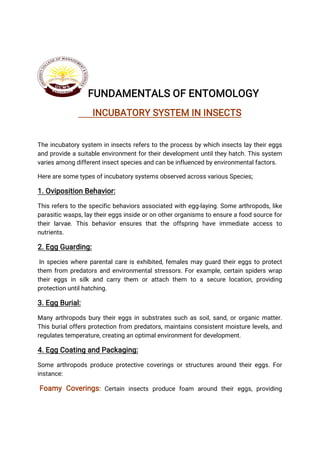Insects INCUBATORY SYSTEM/Insects Life cyclepdf
Insects typically undergo a process called metamorphosis, which includes distinct developmental stages: egg, larva, pupa, and adult. The incubatory system refers to the conditions and methods involved in the development of insect eggs. Egg Stage: Insects lay eggs in various environments depending on species; these can be laid on plants, in soil, or even within the bodies of other organisms. The outer layer of the egg, called the chorion, protects the developing embryo. Environmental Factors: Temperature and humidity play crucial roles in the incubation process. Different insect species have specific temperature and humidity requirements for successful development. Parental Care: Some insects exhibit parental care by guarding or providing resources for their eggs. This can include building nests, provisioning food, or protecting the eggs from predators. Oviposition Behavior: Oviposition refers to the process of laying eggs. Insects may display specific behaviors to ensure the eggs are placed in suitable conditions for development. Adaptations: Insects have evolved diverse adaptations to optimize incubation. Some species lay eggs in clusters, while others disperse them. Certain insects may use protective coatings or structures to shield their eggs from environmental challenges. Embryonic Development: Once laid, the embryo undergoes development within the egg. This process involves cell division, differentiation, and organ formation. Hatching Mechanism: Hatching is triggered by various factors such as environmental cues (temperature, humidity), mechanical pressure, or specific chemicals released by the developing embryo. Larval Stage: Upon hatching, the larval stage begins. Larvae often have different ecological roles and feeding habits compared to the adult stage. Pupal Stage: In complete metamorphosis, the larva transforms into a pupa, a non-feeding and often immobile stage. This is a critical period for internal restructuring. Adult Emergence: After the pupal stage, the adult insect emerges. The time required for each stage varies among species, influenced by factors like temperature and nutrition.

Recommended
Recommended
More Related Content
What's hot
What's hot (20)
Similar to Insects INCUBATORY SYSTEM/Insects Life cyclepdf
Similar to Insects INCUBATORY SYSTEM/Insects Life cyclepdf (20)
Recently uploaded
Recently uploaded (20)
Insects INCUBATORY SYSTEM/Insects Life cyclepdf
- 1. FUNDAMENTALS OF ENTOMOLOGY INCUBATORY SYSTEM IN INSECTS The incubatory system in insects refers to the process by which insects lay their eggs and provide a suitable environment for their development until they hatch. This system varies among different insect species and can be influenced by environmental factors. Here are some types of incubatory systems observed across various Species; 1. Oviposition Behavior: This refers to the specific behaviors associated with egg-laying. Some arthropods, like parasitic wasps, lay their eggs inside or on other organisms to ensure a food source for their larvae. This behavior ensures that the offspring have immediate access to nutrients. 2. Egg Guarding: In species where parental care is exhibited, females may guard their eggs to protect them from predators and environmental stressors. For example, certain spiders wrap their eggs in silk and carry them or attach them to a secure location, providing protection until hatching. 3. Egg Burial: Many arthropods bury their eggs in substrates such as soil, sand, or organic matter. This burial offers protection from predators, maintains consistent moisture levels, and regulates temperature, creating an optimal environment for development. 4. Egg Coating and Packaging: Some arthropods produce protective coverings or structures around their eggs. For instance: Foamy Coverings: Certain insects produce foam around their eggs, providing
- 2. protection from desiccation and predators. Hardened Casings: Some crustaceans and insects create hard shells or casings around their eggs, offering physical protection. 5. Nutrient Provisioning: In some species, females provide nutrients to their eggs during or after oviposition. For example, female beetles may lay eggs near suitable food sources, ensuring that the emerging larvae have immediate access to nourishment. 6. Environmental Manipulation: Certain arthropods modify their environment to create favorable conditions for their eggs. For instance: - Nest Construction: Some insects construct nests or chambers where they deposit their eggs, regulating conditions like humidity and temperature. - Water Management: Aquatic arthropods, like certain crustaceans, may attach their eggs to structures or carry them in specialized brood pouches, ensuring adequate oxygen supply and protection. 7.Developmental Stages :Once eggs are laid, they undergo specific developmental stages, depending on the arthropod group. These stages involve cellular division, differentiation, and organ formation. The duration of the incubation period varies widely, from a few days to several months, based on species and environmental conditions. 8. Hatching Mechanisms: After the incubation period, eggs hatch, releasing larvae or nymphs, depending on the species. Arthropods eggs hatch through various mechanisms: - Environmental Cues: Some species use environmental cues, such as temperature or moisture changes, to trigger hatching. - Structural Adaptations: Certain arthropods have specialized structures or behaviors, like egg bursters or movements, to aid in the hatching process.